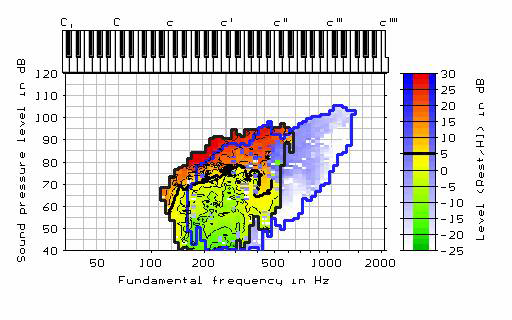New method of mapping the voice could improve the treatment of voice patients
The measurement methods commonly used in voice therapy do not usually take into account how different individual voices are. A new thesis from KTH presents a method by which a person´s entire voice range can be measured. In particular, various aspects of the quality of the voice can be can be quantified. The method can be of great importance to people with voice problems, and also to singers who want to develop their voice.

A healthy voice can span frequencies from 80 to 1500 Hertz, and sound levels from 40 to 120 decibels or more. These limits have a diagnostic value even in themselves. An impaired voice is often unable to be as strong or as soft, or as high and low in range, as a healthy voice.
Recording sound is easy, but the acoustic properties of a voice depend on very many factors. This makes it difficult to find universal and objective acoustic criteria, that might be used clinically and pedagogically for checking the status of a voice. In addition, the evidence so far for acoustic diagnosis has been weak. With his dissertation, researcher Peter Pabon shows the reasons for this. He also shows that it is possible to map a voice in detail throughout its entire range.
With the measurement methods used today, only a few samples are taken at a few sound levels and frequencies. With Peter Pabon's method, the clinician gets a comprehensive map, rather like the audiogram that is used to describe someone’s hearing.
Among other things, the results in the thesis show that it is important to base examinations on the individual's own voice, when measuring the effects of voice therapy or so-called phonosurgery. This is quite unlike the methods used today, which are based on the norms of a population.
“In voice therapy, you assume that voices are relatively similar and compare them with each other. But this method, where you map the entire range of a voice, shows how incredibly different voices are and that it is impossible to compare one voice with other voices. The method makes it possible to compare a voice with itself, and that is what I show in this thesis,” Peter Pabon says.

Pabon has constructed a special recording system, enabling a speech therapist and a patient (or a vocal teacher and a student) to see in real time how different voice characteristics vary with voice and pitch. Specific acoustic measurements are visualized with different colours. These colours reflect parameters such as a pressed or a breathy (leaky) voice (a voice where too much air passes through the vocal cords, thus making it weak). The method provides a map of the patient's (or the singing student´s) voice behavior. After a treatment session or an exercise, you can make a new map to see if the voice behavior has changed.
“By examining the entire voice range, when you change the pitch, you can find out how big a person´s voice range is. At the same time, you will see which sound levels and which pitches you have already tested before. So you build the map interactively using the visual feedback,” Peter Pabon says.
Peter Pabon has been working on this method for more than 30 years – starting with research projects in the Netherlands, and then developing a product that is used by voice therapists and vocal teachers, mainly in Holland and in Sweden. A few years ago he decided to go back to doing research and to take a PhD at KTH.
“A professor I worked with previously in Holland told me always to cooperate with the best people. Therefore, I decided to go to a place where there are people who really know about and understand these things. So it was for quality reasons I chose KTH, where Sten Ternström's research team is located,” Peter Pabon says.
For more information, contact Peter Pabon´s supervisor Professor Sten Ternström: +46 8 790 78 55 / stern@kth.se
Håkan Soold